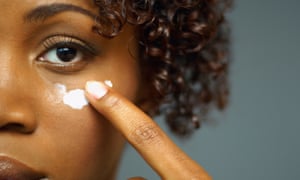
Anyone who has ever glanced at a lotion or shampoo bottle has probably noticed a mystifying array of multi-syllabic chemicals. We assume they’re safe enough to put on our bodies – but how much do we really know about the products we slather on each day?
The US cosmetics and personal care industry – everything from makeup to shampoo, lotion and sunscreen – is largely self-regulated. Since it first came under FDA purview in the 1930s, the industry has had only nine chemicals banned from use. More than 12,000 chemicals are approved for use today.
Consumer health advocates and some researchers have for years warned that at least some of those are unsafe. And they are trying to connect the dots between these intimately used products and some worrying and unexplained disease trends – particularly in women.
American women use an average of 12 products a day – nearly 200 chemicals – according to a 2004 study by the Environmental Working Group (EWG), a non-profit environment and health advocacy group. Another survey, conducted by a beauty retailer in 2016, found women averaged 16 products a day on their face alone.
“Cancer is on the rise, infertility is on the rise, allergies in children are on the rise, and people can’t figure out why,” said Nneka Leiba, the director of healthy living science at EWG, which has been monitoring chemicals in cosmetics for over a decade. “The increases are not just due to genetics and new diagnostic techniques.”
In the US, overall cancer rates have declined in recent years, but certain types of cancer – including those of the thyroid, liver and skin – are on the rise, according to the latest government data. And while the rate of cancer diagnoses among men is decreasing, rates for women have remained stable since 2008.
Leiba said known or suspected carcinogens like formaldehyde – found in some keratin hair treatments, body soap and nail polish – and coal tar – found in some hair dyes and shampoo – are of top concern in beauty products. So are heavy metals, like lead found in lipsticks and clay-based products, and endocrine-disrupting chemicals like parabens and phthalates, among others. EWG has also found toxic PFAS chemicals – used in flame retardants and Teflon – in some cosmetics.
EWG, along with other advocacy groups, is pushing for more transparency and regulation of the industry to ban certain ingredients, many of which are already blocked in other countries. A recent report by the organization found that more than 40 countries have banned 1,400 chemicals in cosmetic products, compared with nine in the US.
The Personal Care Products Council (PCPC), the trade group representing 90% of the US beauty industry, says their products are “among the safest” regulated by the FDA, and maintains that fears of certain chemicals are overblown.
“The number of substances on a country’s restricted list is a misleading measure of the effectiveness of regulation in protecting human health and safety,” Lezlee Westine, the president and CEO of the Personal Care Products Council, said in an emailed statement on EWG’s analysis. “The materials cited as examples by EWG are not, and would never be, used as cosmetic ingredients because they are pesticides, narcotics, and radioactive substances.” (EWG’s list includes current cosmetic ingredients like formaldehyde, parabens and toluene.)
While PCPC supports regulatory reforms, Westine stopped short of endorsing the Personal Care Products Safety Act, a current legislative push to increase FDA authority. “We believe well-crafted reforms – grounded in science – will support the industry’s ability to innovate and further strengthen consumer confidence in the products they trust and enjoy every day,” Westine said.
Data on real-world chemical exposure is limited, and most safety assessments look at one chemical and one source at a time. “But we are not using just one product,” Leiba said. “Your exposure in just one day can greatly outweigh what this one company said was the low dose you had in your product, which is why we are concerned.”

Women, especially black women, have been found to have a higher body burden of certain chemicals found in cosmetics, including parabens and phthalates. Both are endocrine-disrupting chemicals, which mimic human hormones. Of particular concern to researchers, they can have effects at very small doses and have been linked to numerous health issues.
“If you think about the chronic conditions that the world is experiencing now – like fertility problems, thyroid conditions, diabetes, ADHD – these are all heavily impacted by hormones,” said Carol Kwiatkowski, the executive director of The Endocrine Disruption Exchange (TEDX), a not-for-profit research foundation focused on reducing harmful chemicals in the environment. “Prevalence rates are skyrocketing. We just don’t know what is causing it. It’s undeniable that environmental chemicals are part of the picture. And we just continue to ignore them.”
More than 200 possible endocrine-disrupting chemicals currently in use in cosmetics and personal care products have been identified by TEDX.
The FDA and Centers for Disease Control and Prevention have said the health effects of phthalates, parabens and many other environmental chemicals are not conclusive. Industry groups maintain that endocrine-disrupting chemicals in cosmetics and personal care products are present at very small doses and are safe.
A big unknown is how chemicals interact with each other in the body after they are absorbed through the skin, according to Leiba. “We are talking about how phthalates may combine with parabens, for example, because they’re both endocrine-disrupting chemicals,” she said. “So, are the endocrine-disrupting effects additive? Or do they multiply the effects because they’re both acting on the same hormone systems?”
For now, data from so-called mixture studies, which look at the effects of chemical cocktails likely to be found in the real world, is limited but growing. But it remains difficult to draw a direct line between these chemical exposures and health problems that may occur years or even decades later.
“The problems you see that happen from early life exposure, which may be where most of that is coming from … when you try to connect that to things like fertility problems, or Alzheimer’s or Parkinson’s, it’s nearly impossible,” Kwaitkowski said.
Untangling the causes of disease is a complex task, and not everything in your medicine cabinet is a potential diagnosis waiting to happen. “Most ingredients used in our day-to-day life are probably pretty safe,” cautioned Melanie Benesh, a legislative attorney for EWG. But with all the question marks around chemicals found in beauty products, health advocates say, a more precautionary approach is warranted – not unlike warnings from past public health crises.
“It’s unfortunate that we have to be seeing these health impacts in our society before we make changes,” Leiba said. “How many people had to die before we realized that smoking actually causes cancer?”
[“source=theguardian”]









